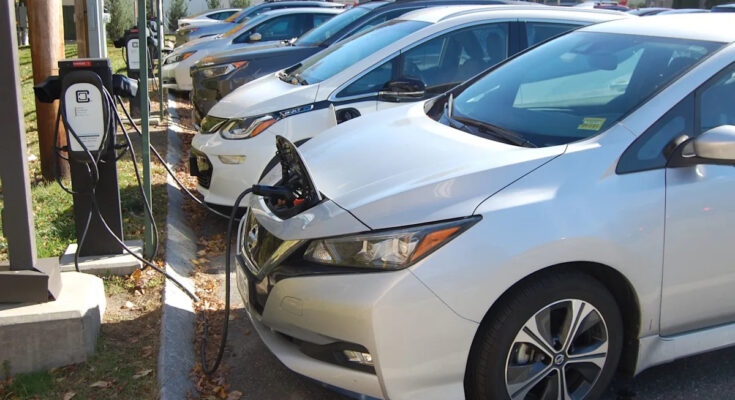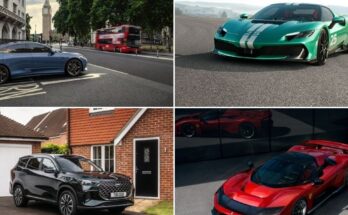Federal rebates on new and used electric vehicles will now expire at the end of September
When shopping for a car, one rule of thumb is to time your purchase so the seller is motivated to sweeten the deal in order to move vehicles off their lot, such as at the end of the summer when next year’s models start rolling in.
This year, shoppers considering new or used electric and plug-in hybrid vehicles might find deals are extra sweet before two federal tax credits go into early retirement on September 30.
Among the hundreds of provisions in the One Big Beautiful Bill Act signed by President Donald Trump on the Fourth of July are two cuts implicating the EV industry. The clean vehicle credit and previously owned clean vehicle credit put in place in their current form by the 2022 Inflation Reduction Act were originally set to run through 2032.
Under the new legislation, the $7,500 rebate for new vehicles and 30% or $4,000 credit on used vehicles will expire at the end of September.
“Anybody that’s on the fence, that’s their deadline to make a decision by, if they do want to take advantage of this,” said Chuck Hayward, EV Infrastructure Designer & Analyst at ReVision Energy, a solar and EV charger installer based across Northern New England. After September, Hayward said it’s uncertain how the market will respond to the change in policy.
Eliminating the two tax credits is expected to save the federal government $85.4 billion over the next decade, per New York Times reporting based on analyses from the Congressional Budget Office. For scale, the entire OBBB will add an estimated $4.1 trillion to the national debt during that same timeframe.
In Maine, it’s unclear what the end of these tax credits means for the state’s goals around increasing EV adoption. Last year’s update to the state climate action plan aims to put 150,000 electric and plug-in hybrid vehicles on the road by 2030.
At the end of 2024, Maine Department of Environmental Protection estimated there were 17,492 EVs on the road in the state. Loren McDonald, chief analyst at Paren, a data firm tracking EV analytics, models future EV adoption.
By accounting for car models like Tesla Model Y or Nissan Leaf that either already exist or are expected to hit the market over the next few years, McDonald creates state-level forecasts for EVs on the road. In Maine, McDonald expects just over 61,500 EVs to be operational by the end of 2030, less than half of the state target.
Maine’s 150,000-EV goal, said McDonald, agreeing with previous evaluations, might not be realistic.
“I could be way off, but they’re gonna have to step it up,” McDonald said of the state’s EV plans. In response to an inquiry about the 150,000-EV goal, the Governor’s Energy Office wrote that the target is built upon comprehensive greenhouse gas emissions modeling and that making progress toward it will require “continued work on a variety of fronts, particularly with recent federal legislation and policy changes.”
State level EV incentives largely unchanged
Currently, Maine has several programs in place to incentivize EV adoption, which are offered through Efficiency Maine Trust, the quasi-state agency for energy programs. A new initiative that began in April encourages “off-peak” charging, or avoiding charging EVs during the window where the grid experiences its peak demand on weekday evenings.
This initiative offers a $300 discount for the purchase and activation of a special EV charger that’s configured to charge only during off-peak hours unless the user overrides it, bringing the net cost of the charger down to $129 for consumers.
Per Efficiency Maine’s Executive Director Michael Stoddard, this program will soon begin offering rebates on vehicles purchased in conjunction with off-peak chargers for “high-barrier customers,” including low- and moderate-income drivers, businesses, and government entities.
While the exact value of those vehicle rebates has not yet been set, it will be similar to rebate levels for low- and moderate-income EV buyers of the program in prior years, which ranged from $2,500 to $7,500 and served 460 customers, according to information Efficiency Maine provided to The Maine Monitor.
On the charging side, the state’s current funding opportunities for building public EV infrastructure will not be impacted by the passage of the OBBB, per Stoddard.
Though awards have yet to be made for this most recent round of projects, any federal funds drawn from the National Electric Vehicle Infrastructure Formula Program, known as ‘NEVI’, and from the Charging and Fueling Infrastructure Grant Program, are fully obligated to Maine in the form of signed agreements and are not impacted by the new legislation, according to Stoddard.
Beyond September 30, McDonald said he’s optimistic that the loss of the tax credits won’t have much of a long-term impact on buyers’ mindsets. With more affordable EVs expected in the next two years, the lower sticker prices could negate the need for a tax credit altogether, he said.
“People have short memories,” McDonald said. “A year from now, nobody’s gonna be going into their dealers going, oh, I’d buy that EV over there except the tax credit’s gone.”



